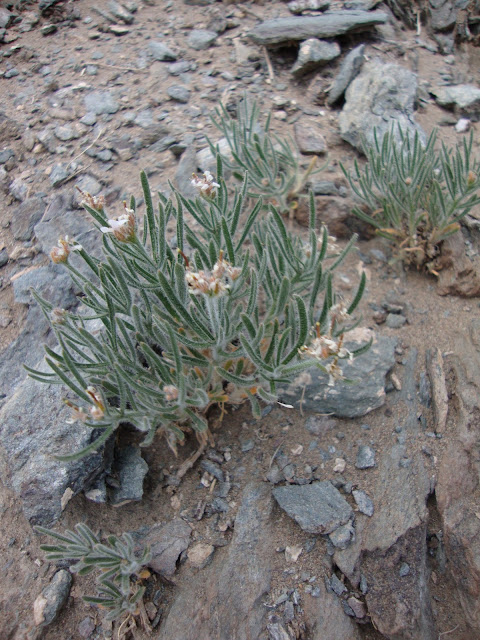 |
| View of Mongolian steppe west of Bayan Olgii |
I think the image above does a good job of conveying the majesty of the Mongolian steppe: we drove quite a ways from Bayan Olgii to the lofty Altai in the very westernmost corner of the country, stopping only a few times. The pictures below were some taken then, as were the shots I featured in
the blog of Panzerina and Goniolmon that kicked off this Mongolian flora series.
 |
| Iris lactea |
We found this iris past bloom in Kazakhstan, and of course, we know it well in Denver: in the course of the 1980's we grew this from many sources in the Former Soviet Union, and have many of the plants thriving in the Rock Alpine Garden to this day (where they're somewhat weedy, I admit). I am amazed that a plant that looks so much like our Rocky Mountain iris is not very closely related and much easier for us to grow than our abundant and widespread native species!
 |
| Iris lactea closer up |
This was a striking form rather different from those we already grow: but no seed on it, alas!
 |
| Astragalus sp. |
The
Virtual Flora of Mongolia (click to access) attests that there are 117 species of
Astragalus in Mongolia, less than half of which they show records of. For rock gardeners, this would be near the top for interest's sake. I scrolled the list and did not find an obvious match.
It made some good sized hummocks...
 |
| Convolvulus ammannii |
We saw quite a few plants of this--and I suspect it would be adaptable to rock garden conditions and not too weedy...

This is probably a larger specimen of the same bindweed: although I fantasize it could be a small
Convolvulus fruticosus or perhaps even
Convolvulus gortschakovii (worth Googling)--the only other species which it might resemble somewhat in Mongolia. A choice genus in that country if you overlook
Convolvulus chinensis!
 |
| Dracocephalum bungeanum |
I was amazed to see this growing on dry steppe: it was otherwise only seen at high elevations on tundra--where it was in peak bloom as well. We found this wonderful dragonhead several places on the steppe, looking identical to the alpine forms, only a tad sparser at the lower levels...
Dracocephalum bungeanum
 |
| Dracocephalum bungeanum |
 |
| Asteraceae Cichoriaceae tribe. |
 |
| Polygonaceae (Atraphaxis?) |
 |
| Rhinactinidia limonifolia |
I will not swear to this identification.
I will not swear to this identification.
 |
| Brassicaceae sp. |
When I tried to run this through a key, I got
Braya rosea--which would be wonderful if true. There's only a line drawing or two on the web--and it could be so.

This is possibly
Dontostemon integrifolius.
 |
| Another crucifer I can't identify |
A particularly attractive Umbellifer: it seems to approximate
Lithosciadium multicaule, which is widespread in Central Asia, and tends to be saxicole as the name implies.
A half dozen species of toadflax are listed for Mongolia, these two are the likeliest species for the one I photographed.

A mystery Caryophyllacae--looking like a Stellaria, of which there are 16 species listed for Mongolia, most of which are noted as occurring in this area.
 |
| Stellaria sp. |
Another Stellaria sp. from a different stop.
 |
| A. vodopjanovae, (akin to Allium mongolicum) |
Thank you, Mark McDonough, for coming through with the I.D. a SECOND time!
 |
| Goniolimon speciosum |
 |
| Goniolimon congestum |
 |
| Artemisia frigida |
Closely resembles fringed sage I found across Kazakhstan--not to mention the Western United States!
 |
| Hedysarum sp. |
 |
Saussurea sp.
|
Forty nine species are known in Mongolia, almost half of which resemble this!
 |
| Potentilla sp. |
Sixty species of Potentilla occur in Mongolia...half of which look a bit like this...
I can't even guess this to family for sure. Mark McDonough suggests
Plantago spp?
 |
| Ancient bonsaied steppe shrub |
Either a chenopod or possibly in the Polygonaceae: I don't believe there were flowers to confirm its identity--an example of how plants often survive much longer in stressful environments than in lush habitats.
 |
| Astragalus cf brevifolius or Astragalus cf. junatovii Sancz. |
Possibly the same as the last species--from a different locale...
No end of Astragalus...

And Oxytropis...
 |
| A distinctive umbel |
If it were America I would call this
Lomatium.
 |
| Caryophyllaceeae... |
Thjese images were random in the extreme...we stopped very briefly two or three times between the town of Bayan Olgii and the mountains we were to spend a week crossing. As everywhere that you find steppe, the flora is really much richer at the foot of the mountains than up top...It would be enormously rewarding to spend an entire spring criss crossing these majestic, empty steppes--empty of people yes, of plants--nothing could be more rewarding!










































The Allium you show is A. vodopjanovae, (akin to Allium mongolicum), I was hoping you'd show this photo. The species is from Mongolia & adjacent southern Siberia, described in 1985 by Dr. Nicolai Friesen. There are perhaps only a dozen photos of this available on the web, you photo shows it well.
ReplyDeleteThe unknown plant below the Potentilla pic, with linear fussy leaves, might it be a Plantago species?
LOL, in previous message, meant to say "fuzzy leaves", my keyboard was being fussy ;-)
ReplyDeleteThis comment has been removed by a blog administrator.
ReplyDelete